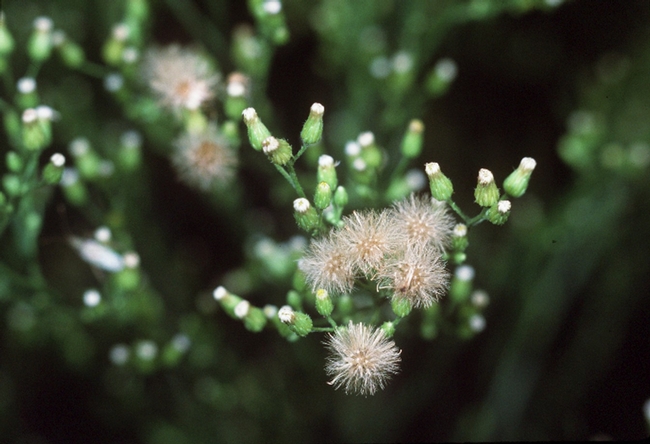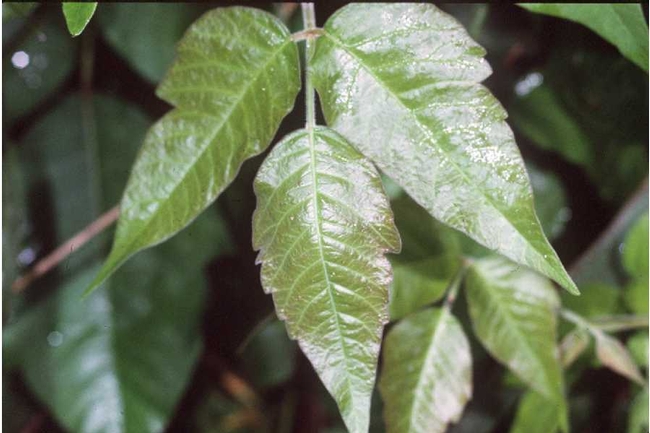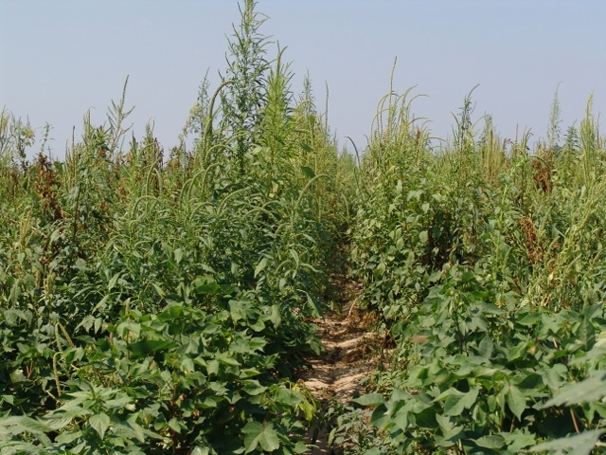It's the 4th of July!
Time for fireworks! (Yay!) Time for picnics! (Yay!) Time for parades! (Yay!) Time for weeds! (Huh? What?)
That's right, weeds. While it is true that many problem pest plant species were imported from Europe and Asia, a lot are also home-grown. Here's just a few facts about three interesting and native species: horseweed, Palmer amaranth, and poison ivy. Happy Holidays!
Conyza canadensis (Erigeron canadensis) a.k.a horseweed, marestail
Horseweed is an annual species native to North America that can now be found in Eurasia and Australia, as well. It can be found in all of the lower 48 states and much of Canada; it has been introduced into Hawaii and Alaska. Leaves are alternate, linear, toothed and hairy. Plants start off as a compact rosettes, but eventually bolt to send up stalks that can reach heights up to seven feet. Horseweed flowers are carried in a dense inflorescence at the top of these stalks; seeds are wind-dispersed and can be dispersed considerable distances by air currents. Young plants may be mistaken for hairy fleabane (Conyza bonariensis), which also occurs un the state; the species can be distinguished from each other by color (horseweed leaves tend to be dark green whereas fleabane leaves are more grey) and by size and branching patterns (mature horseweed plants are much larger, but less branched, than their fleabane relatives). In California, horseweed can be found in a diversity of habitats including: canal backs, ditches, agronomic crop fields, orchards and vineyards, roadsides, and other unmanaged places. Populations of horseweed with resistance to glyphosate, alone, and glyphosate and paraquat have been identified in California. If you want to look at this weed from the bright and useful side, native Americans were reported to have made teas from the leaves and the roots to treat dysentary and menstrual issues, respectively.
More information about horseweed can be found at the following websites:
http://www.ipm.ucanr.edu/PMG/WEEDS/horseweed.html

Amaranthus palmeri a.k.a Palmer amaranth, Palmer pigweed, carelessweed
Palmer amaranth is a dioeocious (meaning that male and female flowers are produced on separate plants) annual that is native to Sonoran Desert and Northern Mexico. Being an amaranth, Palmer looks similar to many other pigweed species at the seedling stage, although mature plants may appear as though they are on steroids. Big, mean, angry steroids, at that. (Palmer amaranth plants can grow several inches PER DAY to reach heights up to 10 feet or even more. The basal portion of the stem can be 2-3 inches in circumference.). The best identifiers of Palmer amaranth, to date, include: 1) petioles that are as long, or longer, than the leaf blades, 2) a white 'V'-shaped marking (chevron) on the leaf blade, and 2) male and female flowers that are held on separate plants in long, terminal spikes. The female flowers possess pointed bracts that make the flower-heads sharp to the touch; male flower-heads, in comparison, are much softer. The reproductive potential of the species is astounding; under ideal growing conditions, a single female plant can produce >500,000 seeds. Palmer amaranth populations in the US have developed resistance to several herbicide mechanisms of action including microtubule-inhibitors (trifluralin), photosystem II-inhibitors (atrazine), ALS-inbibitors (pyrithiobac, others), HPPD-inhibitors (topramezone) and EPSPS-inhibitors (glyphosate); several populations with resistances to more than one mechanism of action have also been identified. Although young Palmer amaranth plants may be eaten like spinach (there are reports of Native American tribes doing so), they do not remain tender for very long; the fast growth rate results in the plants becoming very tough very quickly. Additionally, it has been reported that Palmer can accumulate oxalates and nitrates as the plants age.
For more information on Palmer amaranth please see:
//ucanr.edu/blogs/blogcore/postdetail.cfm?postnum=8989
Palmer amaranth in cotton: Picture by Larry Steckel, University of Tennessee.
Toxicodendron radicans a.k.a eastern poison ivy
"Leaves of three, let them be!" At least that is what I learned growing up. I had to include poison ivy as it is one of North America's most infamous and irritating (literally) weeds. Eastern poison ivy can be found in every state east of Texas, Kansas and Nebraska. Western poison ivy (Toxicodendron rydbergii) has been reported in most of the western states, the northern great plains and the north east. Two other Toxicodendron spp. (the Pacific and Atlantic poison oaks) round out this miserable group. Suffice to say, regardless of where you live in the lower 48 states, you are likely to run into one of these buggers. All of the aforementioned are woody vines or shrubs in the sumac family that produce a substance, called urushiol, that can cause the allergic reaction that many of us are so familiar with. Medically-defined as 'urushiol-induced contact dermatitis', these allergic reactions manifest as itching, inflamed, blistering and oozing rashes. I've heard stories (from friends of friends) that burning the wood of Toxicodendron spp. can result in the oil becoming volatilized and then inhaled resulting in internal injuries to the respiratory tract. In fact, the CDC specifically recommends not burning these plants as severe lung irritation can occur.
One of the best sites for species identification and injury prevention (or first aid if you are unlucky) can be found at:
http://www.cdc.gov/niosh/topics/plants/

